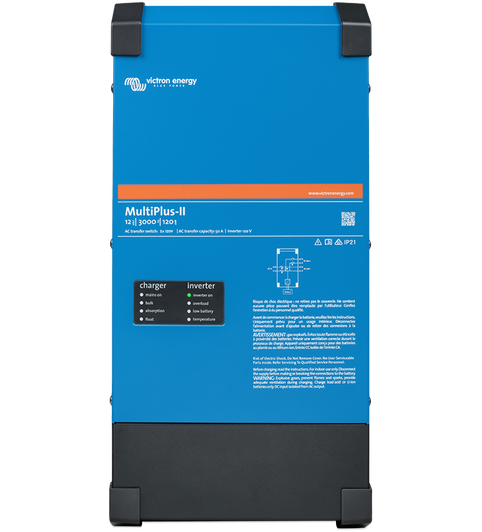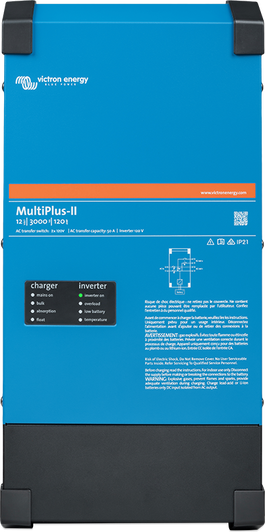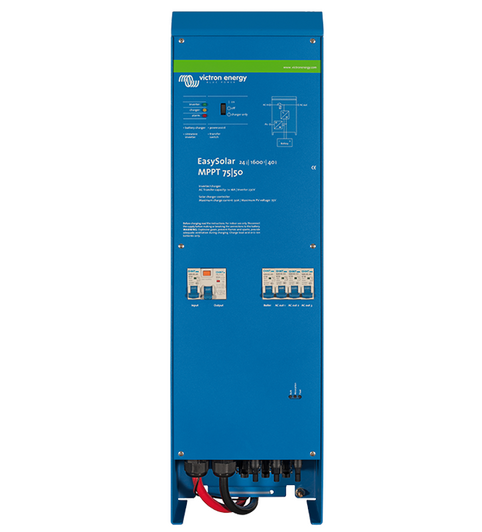Understanding Victron’s Inverter/Chargers
Victron makes so many inverter chargers. And they make them for a really wide set of applications. So today, I want to talk about how to pick the rightVictron inverter charger for your RV in America.
I'm Emily. I'm a certified mobile RV repair tech and solar installer here in Las Vegas,and this is RV Repair woman.
So a couple notes on how we're going to narrow down all of these inverter chargers to what's going to work best for you. First of all, Victron is an international company and they're based in the Netherlands. So they make a whole set of products that aren't made for American applications. For instance, here in America, our outlets look like this, and they put out 120 volts AC.
Whereas in pretty much every other part of the world, the outlets can look very different, and they put out 230 volts. So we can already eliminate a good chunk of Victron's product line, because it creates voltages that we just don't use here. Along a similar vein, Victron makes products for a really wide set of applications, from small boats and RVs, All the way up to large Sticks and Bricks applications. When it comes to RVing , we're really in the mid to small side of their target demographic. Which means, again, we can eliminate a whole set of their products because they're just bigger than what we're trying to do. So, for instance, if we look at the battery banks that Victron's inverter chargers work with, They make inverter chargers that can work with 12 volt, 24 volt, and 48 volt battery banks. In RVs, we really only use either 12 volt or 24 volt battery banks, so we can eliminate pretty much all of the 48 volt inverter chargers. I guess you could do a 48 volt application in an RV. That would just be a huge battery bank for an RV. It would be a really niche application and just something we're not going to talk about today.
And then a couple other housekeeping things before we go down the inverter charger rabbit hole. Victron sizes their inverter chargers in a unit called Volt Amperes, or VA on the website.And this was a unit that I wasn't very comfortable with, and I don't think most laymen have heard of. Because in my mind, I was like, volts times amps equals Watts. And volt amperes are just a more complicated version of watts, so just know when you're looking at their website, anytime you see VA, you can cross it out in your mind, replace it with a W, and call it a watt.Which is what I'm going to do today because honestly, Watts is just easier to say than Volts Ampere.
And finally, because I'm American, I converted all of their dimension measurements into inches. Because as a true blooded American, I have no idea how large a millimeter is at all.
On to the inverter chargers.
Multiplus 500 - 1600 VA
The smallest inverter charger in their line, looks like this, And on their website is designated by MultiPlus 500 1600 VA, or Watt. And I think we can all agree, it should have just been called the MultiPlus Mini. It alliterates, it rolls off the tongue, just a missed marketing opportunity.
The size of the case varies depending on which wattage you pick, but the largest 1600 watt of this MultiPlus has these dimensions and comes in right around 22 and a half pounds.
It has one AC input and one AC output.
And it's really only going to be best for really small van builds or truck camper applications that are not trying to run an air conditioner. I have a whole separate video coming out on how to size your inverter for your rig to make sure you're getting a big enough inverter, but just to have some ballpark numbers to keep in mind, an air conditioner all on its own can pull around 1, 600 watts while it's running. And so even the largest of what should have been called the MultiPlus Mini at 1600 watts is just barely going to be able to run your air conditioner, never mind anything else in your rig, like a fridge or your outlet.
But, if you're in a relatively small build, you're chasing 70 degrees, and never really running an air conditioner, and heating your rig and your water with propane, then this MultiPlus might be best for you because of its really compact size.
But for pretty much everyone else, you're gonna need something larger.
Multiplus
Like maybe, the MultiPlus, or as I call, the MultiPlus OG.
Don't get overwhelmed by all of the wattage options that the OG MultiPlus says it has. When we're looking at just the OG MultiPluses that make 120 volts, like here we use in America, you're looking at either 2, 000 or 3, 000 watt options. That's it.
And both come in either 12 volt or 24 volt battery bank applications. The case is aluminum and the size of it will vary a little bit depending on whether you get the 2, 000 or the 3, 000 watt version. But just so we can compare apples to apples later, the 12 volt 3, 000 watt version has these dimensions and comes in around 40 pounds.
What you gain from going from the what should have been called MultiPlus Mini to the OG MultiPlus is not only an increase in wattage, but you also gain an additional AC output. So you now have one AC input and two AC outputs.
A little explanation about that additional AC output, it is meant for non essential loads that you only want running when you're plugged into shore power. So, for instance, you might decide that you are only ever going to use your air conditioner when you're plugged into shore power. [00:06:00] You could wire that air conditioner into that additional AC output, which would guarantee that that air conditioner never turns on when you're boondocking and drains your battery bank. This can be a really useful feature for some rigs.
This MultiPlus is going to be best for mid sized 30 amp RV rigs. Where this squatter, fatter format is just going to fit best in whatever compartment you're going into. This will make a little more sense when we talk about the MultiPlus 2 later and we compare and contrast their formats.
Keep in mind, if you wanted to use an OG MultiPlus in a 50 amp rig, you would need to use two of them, so you could power both legs of your 50 amp rig.
If you'd like an explanation on the electrical differences between 30 amp and 50 amp rigs, let me know in the comments. (Or DM me on Instagram).
But just know, if you used two 3, 000 watt inverters to power a 50 amp rig, you're putting in two relatively large boxes that each weigh 40 pounds, but you would end up with a 6, 000 watt system, which is pretty cool.
Multiplus ii
Onto the MultiPlus II.
Don't get overwhelmed by all of the wattages they list. When you're looking at just the MultiPlus IIs that make 120 volts, it only comes in 3, 000 watts. Which is nice, it narrows down our options fast.
But what does the ii mean, and what does it get us?
That two designation means two different things for Victron, one of which we care about in RVs and one of which we really don't. The first is the multi plus two and the entire two line, as you're going to see later we also have a quattro two, is a thinner and much taller case. So if we look at a 12 volt 3000 watt MultiPlus II in comparison to a 12 volt 3000 watt OG MultiPlus, you'll see that we don't stick out as far, but we are much taller. We're also about two pounds heavier, and the case is made out of steel. This does mean that the MultiPlus 2 does take up about 200 cubic inches more than the OG MultiPlus, which, if you're going into a very small compartment, could make the difference on whether or not it fits.
The second thing that we're gaining with that 2 designation is Victron has added a bunch of safeties and relays so they can meet more codes. Which is something that we don't really have to worry about in RVs because we're not interacting with the grid the way that Sticks and Bricks applications are. So that's something that we don't really need to worry about. The MultiPlus 2 has all of the same features as the MultiPlus including that additional AC output. So when it comes to RVs and choosing between the OG MultiPlus and the MultiPlus 2, it's really going to come down to which size and shape fits best into your RV.
And the MultiPlus 2 can be a little bit cheaper than the OG MultiPlus, so if you're getting really close to your budget for this project, then that might be the direction that you lean.
Again, just like the OG MultiPlus, the MultiPlus II is going to be best for mid sized 30 amp RV applications, and if you are going to put it in a 50 amp, you will need two of them. Which is a lot of space and a lot of weight.
Multiplus ii 2X120V
Which is why they made the MultiPlus II two times 120 volt.
Come on Victron, we gotta come up with cuter names for these.
The Multi plus two two times 120 volt has all of the features of the multi plus two plus we also gain the feature to be able to supply split phase power. Which in layman's terms means you can power a 50 amp rig with just one of these.
Huzzah!
Again, it only comes in 3000 watts, so your dimensions are going to look like this, and you're going to come in at around 48 pounds.
Which makes this MultiPlus the best choice for mid sized 50 amp rigs.
If we were to compare and contrast using one of these bad boys to power a 50 amp rig as opposed to two multi plus twos, one of these is only going to be 48 pounds and only take up one multi plus two worth of space, and you're going to get 3, 000 watts of power.Whereas if we were to use two multi plus twos, it would take up twice the amount of space and twice the weight, but we could end up with a 6, 000 watt system, which might be the right option if you're in a mid sized to larger RV.
The choice is up to you.
Quattro
If you've been watching this whole video and going, Emily, I need more power, then the Quattro might be the choice for you.
Again, don't get overwhelmed by the wattage options when it comes to American applications, the Quattro comes in 5000 watts, and again in 12 or 24 volt applications.
What you're gaining with the Quattro on top of the increased wattage is an additional AC input. So we now have two AC inputs and two AC outputs, hence the name Quattro.
That additional AC input is for a generator, which means that the Quattro has a built in automatic transfer switch. Every inverter charger that we've talked about before this point, if you did have a generator, you would need to have an automatic transfer switch separate from the inverter, upline in the system.
If you already have an ATS and don't need the increased wattage and weight of the Quattro, then you can cut yourself time and labor on wiring and just keep your automatic transfer switch. And then just have that one AC input going into your inverter charger. Nice and simple.
The dimensions of the Quattro come out to this and it comes in at around 66 pounds. She's a chonker.
This is going to be the best choice for larger 30 amp rigs with a generator. And again, just like the MultiPluses, if you are in a 50 amp rig, you would need to use two original Quattros.
Quattro ii
Just like the MultiPlus and the MultiPlus 2, there is a Quattro and Quattro 2.
Editing Emily here, coming from my giraffe filled office. Uh, I explained this really poorly when I first filmed this, but essentially, the Quattro 2 only comes in 230 volts, so we're not gonna use it in America anytime soon. Sorry. Back to the original video.
Quattro ii 2X120 V
And then finally, just like with the MultiPlus 2, 2x120V, there's also a Quattro 2, 2x120V. Which is going to allow you to be able to power 50 amp rigs with just one inverter charger. It only comes in 3, 000 watts, so that narrows down your options really quick.
Its dimensions look like this and it comes in at around 52 pounds.
And that's it for Victron's inverter chargers that work in RV applications. I do want to talk about, just briefly, the other products in their line, and just explain, really quickly, what they are and why they aren't the right choice for you right now, but why you might want to keep an eye on them in the future.
EasySolar and EasyPlus
First, they have their Easy Solar and Easy Plus inverter chargers. These are both attempts to take the full solar system and put it all into one box. So they are combining the inverter charger, the MPPT, and the power distributor all into one box for easy installation.
But unfortunately, both the Easy Solar and the Easy Plus only come in 230 applications right now, and the cases are kind of on the larger side. So, for right now, these are not the right choices for going into an RV in America.
GX Line
And then I also wanted to talk about their GX line.
As you can see right now, they sell a MultiPlus 2 GX and an EZ Solar 2 GX. That GX means that there is built in remote monitoring, so you can check on your system and change settings with just an app on your phone. This is a functionality you can add to RV systems using [00:14:00] additional accessories, but Victron has built in this communication functionality straight into the box of these two systems. This is a really cool feature, but unfortunately, right now, the MultiPlus 2GX and the EasySolar 2GX Only come 230 volt applications, so they're not going to work in RVs in America as of right now.
But that is a feature that you may want to keep an eye on in the future, because this does seem like a direction they're moving with the company, and I could see them rolling out this feature to 120 volt applications in the future.
Wooooowee!
That is Victron's entire line of inverter chargers, and I hope it helped narrow down which one is going to be best for your RV and your solar application.
If you would like help with your solar install and are in the Las Vegas area or heading in that direction, hit me up here. I'd love to help you out. This has been RV RepairWoman.
You got this.














